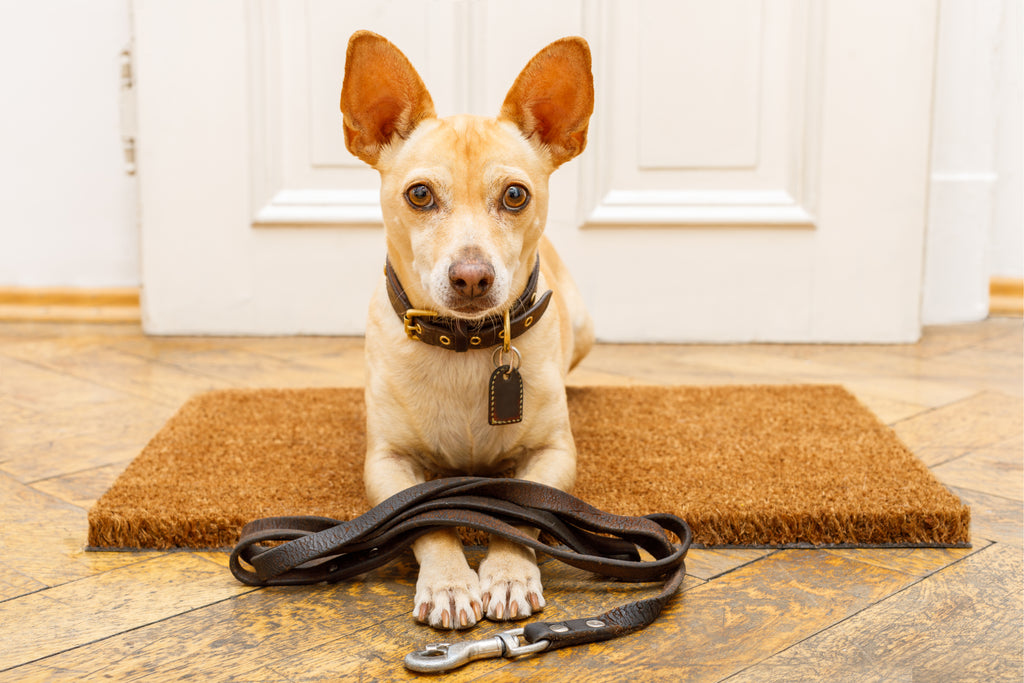
5 reasons why your dog refuses to go for a walk
Dog on a go slow? Just won’t move? Refusing to budge even when you put on your coat and rattle the lead? It’s just not right, is it? Here we look at why your pooch might be dragging their paws and suggest what you can do about it.
It feels completely against the natural order of things when your dog refuses to go for a walk. Going for a walk is one of the great joys of having a dog, and when they lose their enthusiasm for walkies, it’s unnerving.
What could be holding your furry friend back?
1. Your pooch is on the sick list
First things first, maybe your pup’s not feeling very well. It could be something straightforward like sore paws. Sometimes, if you’ve walked your pooch on a hard surface or they’ve skidded to a halt on some gravel, it can tear up their paws.
But if your dog suddenly can’t walk or move at all, or is extremely weak or lethargic, take them to the vet straight away.
2. It’s raining
On a less serious note, perhaps your pup’s not a fan of the rain.
Most dogs love a good walk whether the sky is a cloudless blue or an unrelenting grey.
In fact, we know lots of dogs that positively revel in splashing about in the rain. Puddles are lovely and cooling on the tummy, your fur dries into gorgeous mucky peaks and afterwards you can generously scatter dried mud over your owner’s cream sofa. (You can spatter mud on brown or black sofas too. It’s just less fun.)
But if your dog absolutely refuses to go out in the rain and it’s not an option for you to move somewhere hot and sunny, here are a few suggestions:
- Play with water so your pup associates getting wet with having fun. A light showering with a garden hose on a hot day should do the trick.
- Don’t force it. If your dog really hates wet weather, keep rainy walks short and sweet.
- Lead by example. If it starts raining while you’re out, don’t huff or panic. Dogs pick up on your emotions, so if you stay calm, your dog’s more likely to take the rain in their stride.

3. They’re conserving their energy
Like humans, different dogs have different energy levels. Some breeds are sprinters, others prefer a more sedate pace.
Herding and hunting breeds like Labrador Retrievers, Golden Retrievers and Border Collies are the sprinters in the pack. They’re big bundles of energy and love nothing more than getting out in the fresh air and going… and going… and going. You’re unlikely to outrun these guys.
On the other paw, some dogs are much less driven by the need for speed. The Cavalier King Charles Spaniel is the original lapdog, a Great Dane loves a luxurious lie down and Greyhounds are the world’s fastest couch potatoes. They can go from 0-45mph in seconds, but then they enjoy nothing more than slouching next to you on the sofa while you watch a box set.
Or maybe you’ve got a dog like Charlie, the family Labrador who inspired our founders to create YuMOVE. He was not a fan of running up hills, so he’d wait at the bottom until his owner came back down again.
Some breeds are simply less fussed about going for a walk than others. Check out our dog exercise calculator to find out how much exercise your pup needs.
4. Your walks are boring

The cheek of it! How dare your dog say your walks are boring? But if you always turn left when you leave your house and do the same circuit each time, maybe your hound has a point. Could you do with varying your routine a little?
If you’ve got into the habit of always taking the same route, switch it up. Leave the favourite ball, flinger or toy at home. Go out at a different time of day. If you usually stop at a particular point, keep on moving. Or, if you always take your pooch for a run with you, try a change of pace and make it a walk next time.
The more variety you give your dog, the happier they’ll be.
5. Their joints are stiff
If your dog suddenly loses their enthusiasm for walks, maybe they have stiff joints.
Your dog’s joints are protected by smooth cartilage lubricated by joint fluid, which enables the bones to glide over each other with the minimum of friction. This helps to absorb the shock and bounce every time your dog races to catch a ball or jumps up to play.
But as your dog gets older, there can be less of this cushioning fluid around the joints, causing stiffness. So if your dog’s reluctant to grab the lead and go for a walk, try our all-natural YuMOVE supplements. They contain Hyaluronic Acid to help lubricate and cushion your dog’s joints, as well as high-strength ActivEase ® Green Lipped Mussel and Glucosamine. YuMOVE is proven to work in just 6 weeks[1], helping to soothe stiffness, support long-term joint health and promote mobility.
Here’s what our customer Carol says on Trustpilot:
“I have been giving Shadow YuMove Plus for a while now and he seems to be much better on his walks and bouncing around like a puppy, he is 9.”
What’s your experience?
Do you have any good tips to share about helping your dog to rediscover the joy of a walk? If so, do get in touch and let us know by emailing us at info@lintbells.com.
[1] Study conducted by Royal Veterinary College.








